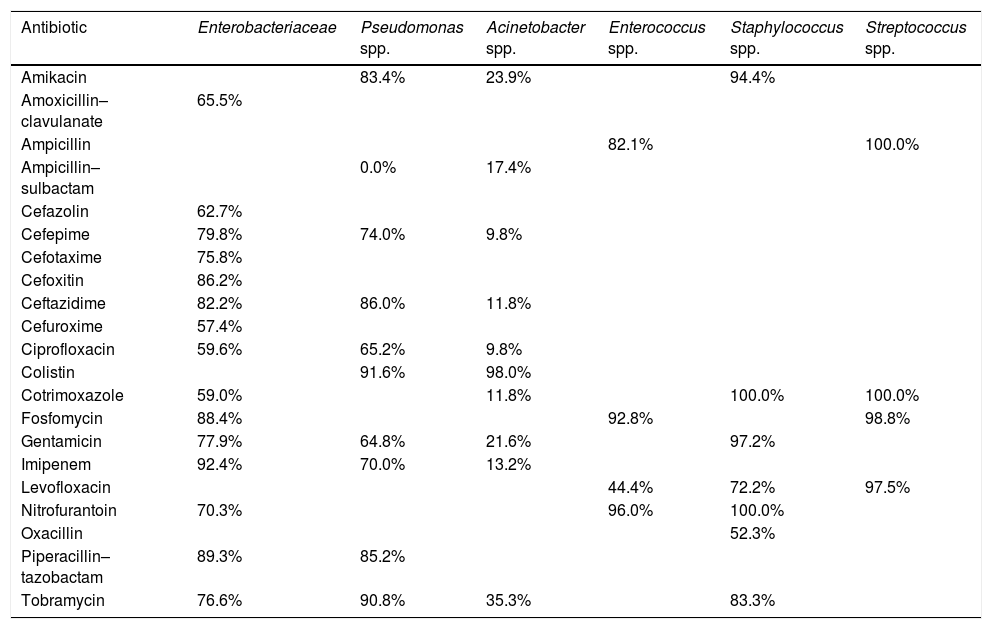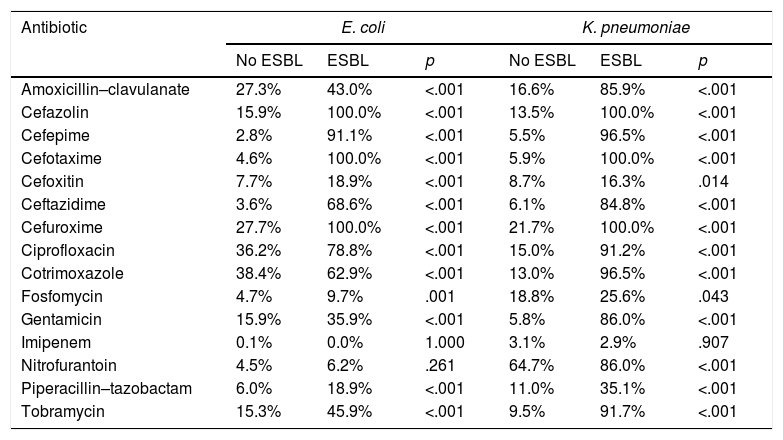Urinary tract infections (UTIs) are the leading cause of infection in hospitalised patients. In this study, we describe the most common pathogens involved in the development of UTIs in hospitalised patients, their antibiotic-sensitivity profile and the activity evolution of antibiotics in standard use for treating these infections.
MethodsWe retrospectively assessed the results of cultures and antibiograms from urine samples from adult patients hospitalised in the Hospital Complex Virgen de la Nieves (Granada, Spain) with a microbiological confirmation of UTI between January 2013 and December 2016.
ResultsWe identified 4347 microorganisms (3969 bacteria and 378 yeasts). During the 4years of the study, Escherichia coli was the most common species isolated in both sexes; however, 62.9% of the UTIs were caused by other microorganisms. The presence of multiresistant microorganisms such as Acinetobacter spp. (1.2%) and extended-spectrum beta-lactamase-producing enterobacteria (10.0%) and carbapenemase-producing enterobacteria (0.3%) were also relevant findings. Imipenem, piperacillin–tazobactam and fosfomycin presented activity rates above 80%, considering all causal microorganisms of UTI, while the other tested antibiotics presented activity rates below 70%.
ConclusionImipenem and piperacillin–tazobactam were the most active antibiotics in hospital use, which makes them first-line antibiotics in the empiric treatment of UTIs in this healthcare setting. The use of other antibiotics should be limited to conditions of demonstrated or highly probable sensitivity.
La infección del tracto urinario (ITU) es la primera causa de infección en pacientes con ingreso hospitalario. En este trabajo describimos los patógenos más frecuentemente implicados en el desarrollo de ITU en pacientes hospitalizados, su perfil de sensibilidad antibiótica y la evolución de la actividad de los antibióticos de uso habitual en el tratamiento de estas infecciones.
MétodosSe evaluaron retrospectivamente los resultados de los cultivos y antibiogramas de las muestras de orina procedentes de pacientes adultos ingresados en el Complejo Hospitalario Virgen de las Nieves (Granada, España) con confirmación microbiológica de ITU entre enero de 2013 y diciembre de 2016.
ResultadosSe identificaron 4.347 microorganismos (3.969 bacterias y 378 levaduras). Durante los 4años de estudio, y en ambos sexos, Escherichia coli fue la especie más frecuentemente aislada; sin embargo, el 62,9% de las ITU estuvieron causadas por microorganismos diferentes a este. La presencia de microorganismos multirresistentes como Acinetobacter spp. (1,2%) y de enterobacterias productoras de betalactamasas de espectro extendido (10,0%) y de carbapenemasas (0,3%) fueron también hallazgos relevantes. Imipenem, piperacilina-tazobactam y fosfomicina presentaron tasas de actividad por encima del 80%, considerando todos los microorganismos causantes de ITU, mientras que el resto de antibióticos ensayados presentaron porcentajes de actividad inferiores al 70%.
ConclusiónImipenem y piperacilina-tazobactam fueron los antibióticos de uso hospitalario más activos, lo que los convierte en antibióticos de primera línea en el tratamiento empírico de la ITU en este ámbito sanitario. El uso de otros antibióticos debería estar limitado a situaciones de sensibilidad demostrada o muy probable.
Article
Diríjase desde aquí a la web de la >>>FESEMI<<< e inicie sesión mediante el formulario que se encuentra en la barra superior, pulsando sobre el candado.

Una vez autentificado, en la misma web de FESEMI, en el menú superior, elija la opción deseada.

>>>FESEMI<<<









